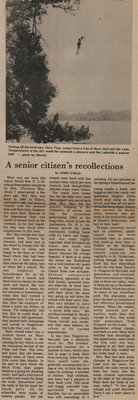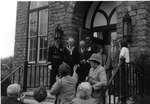A senior citizen's recollections
What was our town like before World War I? A firsthand description was given by Mrs. Florence May, whom I interviewed a few days ago. Mrs. May was born in 1883 in Essex, married in 1905, and came to Canada with her husband Stan and their baby daughter two years later. Because of the depression Stan was unable to secure work on the railroad, as he had hoped, but they soon found other employment in this area.
Mrs. May recalls that they crossed from Toronto by steamer, and were met at the wharf by George Hill. He took them by horse and buggy to the farm on Creek Road where they had been hired. As a farm labourer Stan received the going rate of about $30 a month; Flo was employed as housekeeper for an additional $10 a month, and there was no charge for their room and board. She was also promised a bonus for her services as housekeeper, when they had worked a complete year. At the end of that time the employer offered a mere ten dollars as bonus. Flo indignantly told him that he could keep it. With Stan in full agreement, they packed their belongings and moved to Niagara-on-the-Lake that very day.
Their rented home was a modest house on Mary Street, fairly close to the canning factory which is now the restaurant section of the Pillar and Post. The town had many fine old houses, though some of them were little more than shacks. In the part of town where the Mays lived, most people relied on a pump for drinking water, and had a rain-barrel to collect soft water for doing the wash. Somewhere near the back of the lot stood the family privy. All the sidewalks were made of wooden planks, but the streets were lined with fine mature trees which the town council had thoughtfully planted many years before.
The stores were rather few, for the little town could then support only one of each kind. Mrs. May did her grocery shopping at McClelland's, of course, and had the occasional prescription filled at the drug store, which is now the Apothecary. Dr. H. L. Anderson served the whole community, making house calls by horse and buggy, and was most highly regarded. After his death his house, now made into apartments at 175 Queen Street, became the cottage hospital. A block or so along the street Joe Mulholland ran a well-stocked dry goods store in the building the Corner Store now occupies. Several commercial fishermen, especially in the Ball family, operated from our wharves. In those days before refrigeration they sold their catch the same day, going up and down the streets with their carts. Mrs. May was thrilled to move here, and described this as "a lovely little town." She and Stan attended St. Mark's Church, where the elderly Canon Carrett was rector, and they soon became involved in its various organizations.
At that time Niagara-on-the-Lake had a distinctly rural air. The commoi provided pasture for a number of cows, which were tied to pegs to keep them from straying. After four the boys would come out, generally accompanied by s dog or two, to fetch the cows home for milking. A number of citizens kept chickens, and some had a pig-pen in their back yard. The horse and buggy provided transportation for many families, but an automobile was still something of a curiosity. On one occasion in the spring a friend loaned the young couple a horse and buggy so that they could visit Queenston Heights. Eddie Smith went along as their driver, and they set out gaily along the River Road. Before they reached the escarpment, however, they got stuck in the mud within sight of Brock's Monument, and had to turn back!
Though personal travel had its problems, public transit was far more available than at present. One could go from here to Buffalo on the Michigan Central Railroad. The electric street-car ran regularly to St. Catharines, cutting through the farms. Each day four steamships made the trip from Toronto to Niagara-on-the-Lake and Queenston, and returned. There were summer visitors, just as there are today; most of them put up at the Queen's Royal Hotel, which has given its name to our waterfront park. The steamship company devised an inexpensive but effective promotional scheme. When the vessels, newly painted and attractive, made their first voyage in May, they would take passengers from Niagara-on-the-Lake to Queenston without charge, and back as well. Many local families took advantage of this opportunity; some made the trip only one way, stopping to eat their picnic lunch while they walked the six miles back to town.
Mrs. May has seen many changes in Niagara-on-the-Lake over the years. For herself, the most recent has been her move into the senior citizens' apartments on the edge of the common. What does she think of our town today? "It has good schools and good churches. There's not a nicer place to live!"




